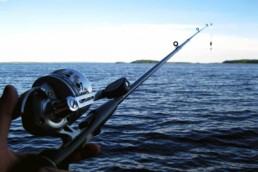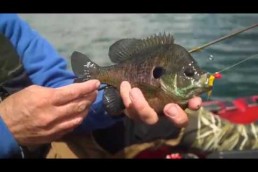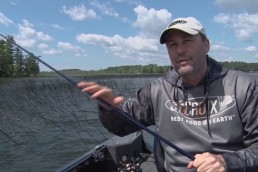The Evolution of Fishing Rods
SHARE THIS POST
In the 1950s and 1960s, anglers used fishing rods that “threw” a lure or bait forward into the water. The leverage from its length propelled the bait forward and anglers trusted it would land near where they wanted.
Today’s rods are “purpose specific,” designed to accurately pitch, flip, or cast a multitude of lure types under a variety of conditions.
Serious engineering and development of rods and reels began in the 1970s with the popularity of tournament fishing. The most popular rig for hardcore bass anglers was a Lew’s Speed Stick and an Ambassadeur 5000C spooled with monofilament line, usually Berkley Trilene or Stren Clear.
The Speed Stick/5000C rig was an example of rugged beauty, with its jet-black fiberglass rod, round shiny black reel, black Fuji line guides, and a black rubber pistol grip. The look did not disappoint for they served anglers well with years of hard fishing.
One of the first fiberglass rods offered in three strengths or powers—light, medium, and heavy—Lew’s was a turning point in rod design. They actually “cast” a lure with control, handling baits from the lightweight Bagley Balsa B to the magnum-sized Arbogast Mudbug.
After inventor Lew Childre died in a 1977 plane crash, Speed Sticks began to lose popularity, however they introduced three quality graphite models in light, medium, and heavy categories.
Under new ownership and leadership since 2009, Lew’s is relying on angler input and technological innovations to drive rod development, following a similar process it used to bring its reels back to market prominence.
“Many folks think we just make reels, but we’re equally committed to making Lew’s the best name in rods too,” said CEO Lynn Reeves. He acknowledged that all of Lew’s Speed Sticks are true to Lew’s heritage of “lighter, faster, and stronger.” New models benefit from common traits like proprietary Advanced Performance Technology (APT) blank construction.
Lew’s Speed Sticks vary in price according to series, ranging from Laser LG Graphite series at $49.99, to the top-of-the-line Team Lew’s HM85 rods at $199.99.
Other manufacturers are adding to their stable of rods, catering to anglers’ needs by developing various lengths, style, and stiffness categories.
Newcomers like Carbon X are bringing their own ideas and strengths to the industry. Their challenge was to build a better fishing tool that delivered the greater fishing performance anglers wanted, which led to the creation of Action Forward Design.
Are you enjoying this post?
You can be among the first to get the latest info on where to go, what to use and how to use it!
“Our rods deliver an impressive increase in fishing performance in two ways. First, with our Action Forward Design we put more of the rod to work for the angler by putting more of the blank where you can use it and that is in front of your hand,” said David Gray, founder of Carbon X Rods.
Combining Action Forward Design with blanks specifically designed for that concept gives anglers the advantage of having more usable rod in front of the reel seat, adding leverage and speed to the hook-set.
“The Action Forward Design puts two to six inches more of additional rod length, when compared to other rods, in front of the reel where it will fish and work for you,” said Gray.
Most rod brands use 10- to 12-inch rear grips on their 7-foot long casting rods while the Carbon X Action Forward Design employs 8-1/4-inch rear grips on 7-foot casting models, creating two or more inches of rod in front of the reel seat. MSRP for Carbon X Rods go from $119.99 to $229.99.
In 1948, St. Croix’s co-founders Bob and Bill Johnson decided to build and sell landing nets. Their quality nets, with cedar handles, ash hoops, and hand-sewn netting, proved too costly for most sportsmen.
A brainstorming session saved the company. Perusing a display of cane fishing poles, the brothers decided to modify them to make them portable. They cut the poles into three shorter lengths and fitted them with brass ferrules. A local hardware merchant immediately ordered 500 rods, and the St. Croix Rod Company was born.
In the 1950s they produced and marketed the first fiberglass rod with the color molded into the rod instead of painted onto it—and the rest, as they say, is history.
While the trend has been method specific for most manufacturers, St. Croix has nearly redefined that process with 22 different series for everything from muskies to ice fishing, including nine new models for 2015 while retaining its Legend Extreme series, an ICAST 2012 Winner for Best Freshwater Rod.
These were examples from just three manufacturers, there are many others like Abu Garcia, All Star, Berkley, B‘n’M, Browning, Denali, Duckett, Daiwa, Eagle Claw, Falcon, Fenwick, G. Loomis, Lamiglass, Okuma, Penn, Pflueger, Quantum, Shakespeare, Shimano, plus brands with retail names like Bass Pro Shops and Cabela’s.
For more information…
Lew’s rods and reels: lews.com.
Carbon X Rods: carbonxrods.com or fishingtacklejunction.com
St. Croix: stcroixrods.com/products
MWO
SHARE THIS POST
Did you enjoy this post?
You can be among the first to get the latest info on where to go, what to use and how to use it!
Darrell Taylor
Darrell Taylor has fished for more than 65 years. During the past 25 years, Taylor has generated more than 2,000 published articles, columns and fishing reports. His writings received 14 peer-level awards from outdoor writer organizations, including the Association of Great Lakes Outdoor Writers “Excellence in Craft” Golden Glow Award, their highest recognition.



